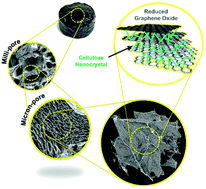Our official English website, www.x-mol.net, welcomes your
feedback! (Note: you will need to create a separate account there.)
Hierarchically porous, ultra-strong reduced graphene oxide-cellulose nanocrystal sponges for exceptional adsorption of water contaminants†
Nanoscale ( IF 5.8 ) Pub Date : 2018-03-26 00:00:00 , DOI: 10.1039/c7nr09037d Nariman Yousefi 1, 2, 3, 4 , Kerwin K. W. Wong 1, 1, 2, 3, 4 , Zeinab Hosseinidoust 1, 2, 3, 4, 5 , Henning Osholm Sørensen 6, 7, 8, 9, 10 , Stefan Bruns 6, 7, 8, 9, 10 , Yi Zheng 11, 12, 13, 14 , Nathalie Tufenkji 1, 2, 3, 4
Nanoscale ( IF 5.8 ) Pub Date : 2018-03-26 00:00:00 , DOI: 10.1039/c7nr09037d Nariman Yousefi 1, 2, 3, 4 , Kerwin K. W. Wong 1, 1, 2, 3, 4 , Zeinab Hosseinidoust 1, 2, 3, 4, 5 , Henning Osholm Sørensen 6, 7, 8, 9, 10 , Stefan Bruns 6, 7, 8, 9, 10 , Yi Zheng 11, 12, 13, 14 , Nathalie Tufenkji 1, 2, 3, 4
Affiliation

|
Self-assembly of graphene oxide (GO) nanosheets into porous 3D sponges is a promising approach to exploit their capacity to adsorb contaminants while facilitating the recovery of the nanosheets from treated water. Yet, forming mechanically robust sponges with suitable adsorption properties presents a significant challenge. Ultra-strong and highly porous 3D sponges are formed using GO, vitamin C (VC), and cellulose nanocrystals (CNCs) – natural nanorods isolated from wood pulp. CNCs provide a robust scaffold for the partially reduced GO (rGO) nanosheets resulting in an exceptionally stiff nanohybrid. The concentration of VC as a reducing agent plays a critical role in tailoring the pore architecture of the sponges. By using excess amounts of VC, a unique hierarchical pore structure is achieved, where VC grains act as soft templates for forming millimeter-sized pores, the walls of which are also porous and comprised of micron-sized pores. The unique hierarchical pore structure ensures the interconnectivity of pores even at the core of large sponges as evidenced by micro and nano X-ray computed tomography. The unique pore architecture translates into an exceptional specific surface area for adsorption of a wide range of contaminants, such as dyes, heavy metals, pharmaceuticals and cyanotoxin from water.
中文翻译:

分层多孔,超强还原性氧化石墨烯纤维素纳米晶体海绵,可出色地吸附水污染物†
将氧化石墨烯(GO)纳米片自组装为多孔3D海绵是一种有前途的方法,可利用其吸附污染物的能力,同时促进从处理过的水中回收纳米片。然而,形成具有合适的吸附性能的机械坚固的海绵提出了巨大的挑战。超强和高度多孔的3D海绵是使用GO,维生素C(VC)和纤维素纳米晶体(CNC)–从木浆中分离出来的天然纳米棒形成的。CNC为部分还原的GO(rGO)纳米片提供了坚固的支架,从而产生了异常坚硬的纳米混合体。VC作为还原剂的浓度在调整海绵的孔结构中起着至关重要的作用。通过使用过量的VC,可以获得独特的分层孔结构,其中VC颗粒充当形成毫米大小的孔的软模板,其壁也是多孔的,并且由微米大小的孔组成。独特的分层孔结构可确保孔的互连性,即使在大型海绵的核心也是如此,这是通过微米和纳米X射线计算机断层扫描技术证明的。独特的孔结构可转化为出色的比表面积,可吸附多种污染物,例如染料,重金属,药物和水中的氰毒素。
更新日期:2018-03-26
中文翻译:

分层多孔,超强还原性氧化石墨烯纤维素纳米晶体海绵,可出色地吸附水污染物†
将氧化石墨烯(GO)纳米片自组装为多孔3D海绵是一种有前途的方法,可利用其吸附污染物的能力,同时促进从处理过的水中回收纳米片。然而,形成具有合适的吸附性能的机械坚固的海绵提出了巨大的挑战。超强和高度多孔的3D海绵是使用GO,维生素C(VC)和纤维素纳米晶体(CNC)–从木浆中分离出来的天然纳米棒形成的。CNC为部分还原的GO(rGO)纳米片提供了坚固的支架,从而产生了异常坚硬的纳米混合体。VC作为还原剂的浓度在调整海绵的孔结构中起着至关重要的作用。通过使用过量的VC,可以获得独特的分层孔结构,其中VC颗粒充当形成毫米大小的孔的软模板,其壁也是多孔的,并且由微米大小的孔组成。独特的分层孔结构可确保孔的互连性,即使在大型海绵的核心也是如此,这是通过微米和纳米X射线计算机断层扫描技术证明的。独特的孔结构可转化为出色的比表面积,可吸附多种污染物,例如染料,重金属,药物和水中的氰毒素。











































 京公网安备 11010802027423号
京公网安备 11010802027423号